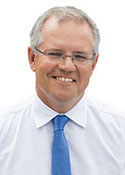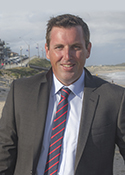Cook
Margin: Liberal 17.3%
Region: Southern Sydney, New South Wales
In a nutshell: Scott Morrison’s seat of Cook has been given an unexpected makeover in the latest redistribution, but remains a safe seat for him and the Liberal Party.
Candidates in ballot paper order

|
JOHN BRETT SCOTT MORRISON GEORGE CAPSIS NATHAN HUNT DAVID ATKINS |
Scott Morrison’s electorate covers the suburbs of the eastern Sutherland Shire, including Kurnell, Cronulla, Miranda and Sylvania. The redistribution has unexpectedly expanded the electorate north of the Georges River to add the St George region suburbs of Sans Souci, Blakehurst and Monterey, adding 22,000 voters from Barton and 6000 from Banks. This is balanced by the loss of 30,000 voters towards the western end of the Sutherland Shire, from Oyster Bay on the river south to Engadine, who go to Hughes. The changes have increased the Liberal margin from 16.4% to 17.3%.
Rapid development in the Sutherland Shire resulted in the creation of two new electorates in the decades after the war: Hughes in 1955, and Cook in 1969. Cook transformed over the years from a marginal mortgage belt seat to a Liberal stronghold, as its demographic profile became older and wealthier while remaining, by Sydney standards, predominantly Anglo-Celtic. The seat was held for the Liberals for the first term of its existence by Donald Dobie, who had won Hughes from Labor in the 1966 landslide. Dobie was unseated in 1972 by Labor’s Ray Thornburn, then recovered the seat on the second attempt in the 1975 landslide. Thornburn followed Dobie’s example in twice recontesting the seat in 1977 and 1980 but was unsuccessful, as all Labor candidates who followed him would be. Dobie held on by 148 votes when the Fraser government was defeated in 1983, and his narrowest margin thereafter was 3.5%. Only in 1998 and 2007 has the Liberal margin since dipped into single figures.
Dobie was succeeded upon his retirement at the 1996 election by Stephen Mutch, who had been a member of the state upper house since 1988. Mutch fell victim after one term to an exercise of power by the party’s moderate faction, which at first backed local barrister Mark Speakman, who had been best man at Mutch’s wedding nine years earlier. The resulting dispute ended with the installation of another noted moderate, Bruce Baird, who had been a senior minister through the Greiner-Fahey NSW government from 1988 to 1995. Mutch’s demise greatly displeased John Howard, who pointedly failed to promote Baird at any point in his nine years in Canberra. It also did not help that Baird was close to Peter Costello, and was spoken of as his potential deputy when fanciful leadership speculation emerged in early 2001. After reports that growing Right control of local branches was putting his preselection in jeopardy, the 65-year-old Baird announced he would bow out at the 2007 election.
Even before Baird’s retirement announcement there was talk of him being succeeded by Scott Morrison, former state party director and managing director of Tourism Australia. According to Steve Lewis in The Australian, Morrison boasted “glowing references from a who’s who of Liberal luminaries, including Defence Minister Brendan Nelson, Environment Minister Malcolm Turnbull, former Liberal president Shane Stone, Howard’s long-time chief of staff Arthur Sinodinos, and Nick Minchin, the Finance Minister and another close ally of Howard”. However, it quickly became clear that such support would not avail him without the backing of the Right, which had been successfully courted by local numbers man Michael Towke. Morrison was further starved of support when moderates resolved to resist Towke by digging in behind their own candidate, Optus executive Paul Fletcher, later to emerge as member for Bradfield.
The ensuing preselection ballot saw Towke defeat Fletcher in the final round by 82 votes to 70, with Morrison finishing well back in a field that included several other well-credentialled candidates. However, Towke’s preselection success met powerful resistance from elements of the party hierarchy, to whom conservative Sydney Morning Herald columnist Paul Sheahan attributed a series of reports in the Daily Telegraph accusing Towke of branch-stacking and embellishing his CV. This culminated in a headline which read “party split as Liberal candidate faces jail”, prompting a defamation action by Towke that was eventually settled in his favour. There were also reports of a whispering campaign relating his Towke’s Lebanese heritage (his surname being a recently adopted Anglicisiation of Taouk), and how it would play in the electorate that played host to the 2005 Cronulla riots. The party’s state executive narrowly passed a resolution to remove Towke as candidate, and a new preselection involving representatives of local branches and the state executive duly delivered victory to Scott Morrison.
Morrison quickly emerged as one of the senior figures in the Opposition, winning promotion to the front bench as Shadow Housing and Local Government Minister when Malcolm Turnbull became leader in September 2008, and securing the high-profile immigration and citizenship portfolio after Tony Abbott deposed Turnbull in December 2009. He further gained productivity and population after the 2010 election, before having his political role sharpened with the title of Immigration and Border Protection Minister following the 2013 election victory. Morrison publicly supported Tony Abbott in the two leadership votes in 2015, but was widely accused of passively allowing Malcolm Turnbull’s challenge to succeed by neglecting to rally his own supporters behind Abbott. These perceptions hardened when Morrison was promoted to Treasurer in place of Joe Hockey, who declined Turnbull’s offer of another portfolio and announced his retirement from politics soon after.
Analysis by William Bowe. Read William’s blog, The Poll Bludger.


